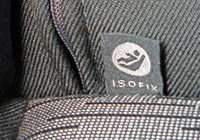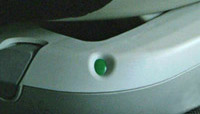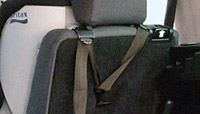Fitting Child Car Seats

If you use the child seat in more than one car, follow the advice below for each car.
Read and follow the manufacturer's instructions for fitting the seat. If you have lost the instructions, check the child seat manufacturer's website as many publish their instruction manuals of their sites. If not, ask the manufacturer if they can provide a copy. Contact details for child seat manufacturers are in the Links section.
There will also be labels on the side of the child car seat showing how it should be fitted.
Some child seat manufacturers also publish short films on their website showing how to fit their seats. You can access lots of fitting videos on our Car Seat Fitting and Compatibility page. If instructions for your seat are not featured on our page or the manufacturer's website, general fitting advice is also available in the "Carrying Children Safely" section on this website.
It's safer to fit child seats in the rear of the car, but if necessary they can be fitted in the front.
But, NEVER fit a rearward-facing baby seat in the front if there is an active airbag on the passenger side of the car. If the airbag went off it would strike the seat with considerable force.
If you are fitting a forward-facing child seat in the front of a car, make sure the car seat is as far back as it will go, so the child is as far as possible from the dashboard. This reduces the possibility of head or chest injuries in a crash.
Child Seats fitted with the Car's Seat Belts

Make sure the seatbelt passes through all the correct guides on the child seat. If the seat adheres to the R44 regulations must go through the blue guides if it is a rearward-facing seat and through the red guides if it is a forward-facing seat. If the seat adheres to the i-Size regulation (R129), the seatbelt guides will be green.Some seats have an alternative routing if the seat belt is too short to go around the main route.
Push your weight into the child seat as you tighten the seat belt to make sure the child seat is securely held. There should be no slack in the seat belt.
Some child seats have a lever or button that can be used to tighten the seat belt once it has been threaded through the child seat.
Many seats have a lock-off device to prevent the seat belt slipping once it has been tightened - make sure this is in the lock position.
The child seat should rest firmly on the car seat, with hardly any forwards or sideways movement.
Check that the seatbelt buckle is not resting on the child seat frame (this is known as 'buckle crunch').
Isofix Child Seats

Isofix seats are not fitted with the car's seat belts. Instead they have connecting arms that slot into Isofix points that were built into the car when it was manufactured. An additional top tether or support leg is used to prevent the restraint from titling or rotating in an impact.
To find out if your car has Isofix points, check your vehicle's handbook or contact the manufacturer or dealer.
To find out if your Isofix child seat is approved for your vehicle, check with the child seat manufacturer or retailer, or with your car manufacturer. Many have a list on their website that shows which seats are approved for which cars. Also, look for labels on your car seat.
i-size
i-size child car seats usually fit into the car's Isofix fitting points, although seats that can be fitted with the vehicle seatbelts are now becoming available. UK legislation has been amended to allow i-size seats to be used in the UK. You will still need to check if the seat is approved for your car. Contact your car manufacturer and/or the child seat manufacturer; many have a list on their website that shows which seats are approved for which cars.
i-size seats will fit any i-size approved vehicle. However, there are few such cars currently available in the UK. Their numbers will increase over the coming years.
Fitting Isofix child seats
- Check that your Isofix seat is approved for use in your particular vehicle. Isofix seats will not fit in every car with Isofix points.
- As with any child car seat, follow the manufacturer's instructions carefully.
- Isofix cars have Isofix slots hidden behind the car's rear seats, in the joint between the back of the seat and the seat cushion. However, in some modern vehicles, the isofix points are more visible. Some cars have a third Isofix attachment point, for a top tether, behind the rear seat to stop the child seat tipping forward in a collision.
 Locate the Isofix points in your car by checking your car's handbook and looking for the Isofix label on the rear seats.
Locate the Isofix points in your car by checking your car's handbook and looking for the Isofix label on the rear seats.- Locate the Isofix connectors (two prongs sticking out of the back) on the child seat or base.
- Push the connectors into the Isofix slots in the car seat. There will be an audible click on many child seats, and/or a visible indicator that turns from red to green, to show that the child seat has been securely attached.
 If using the top tether fixing point, connect the top tether strap to the top tether point in the car. Do not attach it to anything else, such as a head restraint or luggage hook as they will not be strong enough.
If using the top tether fixing point, connect the top tether strap to the top tether point in the car. Do not attach it to anything else, such as a head restraint or luggage hook as they will not be strong enough.- If using a child seat with a supporting leg, make sure that the leg is correctly adjusted so the seat is braced against the floor. Some have a visible indicator that turns green when they are set correctly. Make sure the leg is not sitting over an underfloor storage compartment because this may collapse from the force of an impact coming through the support foot.
Fitting i-size seats
- As with any child car seat, follow the manufacturer's instructions carefully.
- i-size seats fit into the Isofix points in the car, or in some cases can be fitted with the vehicle seatbelt, but you still need to check if the seat is approved for your car. Contact your car manufacturer and/or the child seat manufacturer; many have a list on their website that shows which seats are approved for which cars.
- i-size seats will fit any i-size approved vehicle. However, there are few such cars currently available in the UK. Their numbers will increase over the coming years.
All Seats
Keep the fitting instructions with the child seat in the car.
If you are unsure about anything, seek advice and if possible get someone to check the fitting of child seat for you.
Never modify the child seat or the car seat belt to make it fit.
If you take the child seat out of the car, make sure you fit it properly every time you put it back in. If it stays in the car permanently, check it regularly to make sure it is still securely held.
Instructions
To ensure that child car seats are fitted and used properly, it is essential that the manufacturer's instructions are followed.
Many people do not like reading instruction booklets, preferring to use 'trial and error', but you risk your child being injured if you do not follow the instructions when fitting the child seat.
It is best to keep the instruction booklet with the seat in the car. Many child seats have a pocket for this purpose.
If you have lost the instructions, check the manufacturer's website as they may publish their instructions online. If not, contact them and ask if it is possible to get a copy.
Be particularly careful if you obtain a second-hand seat and make sure it comes with the instructions.
